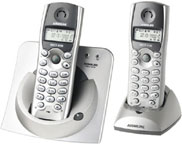Thursday 2 February, 2006, 21:28 - Radio Randomness
 No doubt a lot of people received cordless phones in their Christmas stocking, not least because with cellular phones all the fashion, it seems rather restrictive to have to use a fixed phone at home. Cordless phones come in many flavours, but in particular come in analogue and digital varieties. It's not always that simple to identify, however, which phone is which. In the radio sense, an analogue phone is one which uses analogue modulation (usually FM) to carry the audio to and from the phone. Conversely, a digital phone is one which uses digital modulation. However some unscrupulous retailers who believe that the 'digital' tag is something which sells, often call phones with digital answerphones (i.e. that record messages digitally) as 'digital cordless phones' - they aren't!
No doubt a lot of people received cordless phones in their Christmas stocking, not least because with cellular phones all the fashion, it seems rather restrictive to have to use a fixed phone at home. Cordless phones come in many flavours, but in particular come in analogue and digital varieties. It's not always that simple to identify, however, which phone is which. In the radio sense, an analogue phone is one which uses analogue modulation (usually FM) to carry the audio to and from the phone. Conversely, a digital phone is one which uses digital modulation. However some unscrupulous retailers who believe that the 'digital' tag is something which sells, often call phones with digital answerphones (i.e. that record messages digitally) as 'digital cordless phones' - they aren't!Why does all this matter? Well, only true digital phones offer any level of security over eavesdropping on your calls. Analogue phones are as very easy to tune into (more of which later...) I know of people who have bought 'digital cordless phones' in the belief that their calls were secure. A brief demonstration using a portable receiver as to how easy it is to overhear their calls sent them rushing back to the retailer from who they purchased the phone. Would the retailer swap it for a proper digital phone - not without them paying an additional fee (It's true to say that true digital phones still command a slight margin over analogue phones).
 So how do you know whether the cordless phone you have is digital or not? Well, firstly if it is clearly marked as a 'DECT' phone (usually shown as the letters 'DECT', standing for Digital Enhanced Cordless Telephony, inside an oval shaped blob) then you're fine. As well as being digital, DECT, a European standard, normally operates at frequencies between 1880 and 1900 MHz which means that signals don't tend to travel far outside the house. There is an equivalent American DECT standard known as DCT-U and alternative American digital standards, all operating around 900 MHz.
So how do you know whether the cordless phone you have is digital or not? Well, firstly if it is clearly marked as a 'DECT' phone (usually shown as the letters 'DECT', standing for Digital Enhanced Cordless Telephony, inside an oval shaped blob) then you're fine. As well as being digital, DECT, a European standard, normally operates at frequencies between 1880 and 1900 MHz which means that signals don't tend to travel far outside the house. There is an equivalent American DECT standard known as DCT-U and alternative American digital standards, all operating around 900 MHz.For a practical test, try holding your phone next to an electrically noisy device such as a food blender, electric drill or lift/elevator motor. If you can hear crackles or whooshes over the top of your call, chances are you are using an analogue phone.
In the UK, there are three bands in which analogue cordless telephones, termed CT0 - cordless telephony 0 - to represent the '0th' generation of technology - can legally operate (phones imported from other European countries or outside Europe may operate in different bands).
The first of these bands, specified in UK standard MPT 1322 has a base transmitter on frequencies between 1.642 and 1.782 MHz, just off the end of the medium-wave broadcast band, paired with handset transmitters on frequencies between 47.44375 and 47.54375 MHz with a maximum radiated power of 10mW (erp). They can be identified as the base unit has a wire, up to 3 metres long, which trails out of the back. Using such a low frequency, the base transmitters can radiate over quite some distance. These phones are being phased out in preference to the band identified below, but a tune over the lower frequency band will usually yield a number of units still in operation. The handsets, being low power and with small antennas, tend not to radiate over such a wide area.
In 1996 the Radiocommunications Agency, then responsible for managing the radio spectrum in the UK, realised the need for additional channels for analogue cordless telephony to relieve the congestion that was occuring in the existing bands. A further 8 channels were released (specification MPT 1384) with base units transmitting in the range 31.0375 to 31.2125 MHz, and handsets in the range 39.9375 to 40.1125 MHz again at a power of 10mW (erp). Ranges for the base transmitters vary but can extend to over a km.
 One final range of frequencies is used for long range cordless phones (complying with UK standard MPT 1371) with only two channels available and a maximum radiated power of 100mW (erp). Base units transmit on either 47.43125 or 47.41875 MHz and handsets on 77.5125 or 77.5500 MHz.
One final range of frequencies is used for long range cordless phones (complying with UK standard MPT 1371) with only two channels available and a maximum radiated power of 100mW (erp). Base units transmit on either 47.43125 or 47.41875 MHz and handsets on 77.5125 or 77.5500 MHz.If you have a receiver that tunes across the range of frequencies used by these analogue phones, particularly those used by the base units, have a listen (though obviously I haven't told you to do this as doing so would force you to break the law and I can't possibly condone that kind of thing). It's amazing what range 10mW can give at some of these frequencies. Far be it for me to suggest that you could make a game out of guessing which of your neighbours regularly visits a 'medium', or which one's son has just come out as or which has insurmountable debts or ...! And remember, if you buy a cordless phone for yourself, make sure it's digital!
add comment
( 1288 views )
| permalink
| 



 ( 2.8 / 1253 )
( 2.8 / 1253 )




 ( 2.8 / 1253 )
( 2.8 / 1253 )

